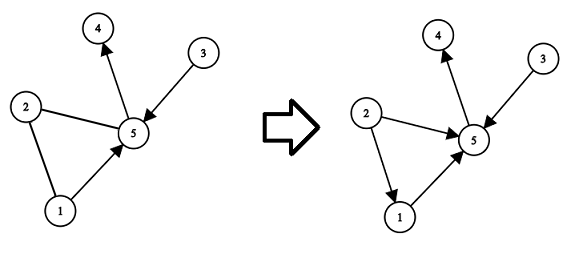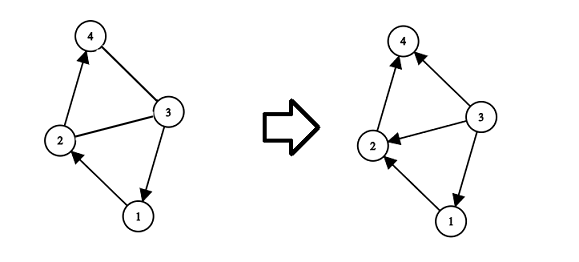| Codeforces Round 656 (Div. 3) |
|---|
| Finished |
You are given a graph consisting of $$$n$$$ vertices and $$$m$$$ edges. It is not guaranteed that the given graph is connected. Some edges are already directed and you can't change their direction. Other edges are undirected and you have to choose some direction for all these edges.
You have to direct undirected edges in such a way that the resulting graph is directed and acyclic (i.e. the graph with all edges directed and having no directed cycles). Note that you have to direct all undirected edges.
You have to answer $$$t$$$ independent test cases.
The first line of the input contains one integer $$$t$$$ ($$$1 \le t \le 2 \cdot 10^4$$$) — the number of test cases. Then $$$t$$$ test cases follow.
The first line of the test case contains two integers $$$n$$$ and $$$m$$$ ($$$2 \le n \le 2 \cdot 10^5$$$, $$$1 \le m \le min(2 \cdot 10^5, \frac{n(n-1)}{2})$$$) — the number of vertices and the number of edges in the graph, respectively.
The next $$$m$$$ lines describe edges of the graph. The $$$i$$$-th edge is described with three integers $$$t_i$$$, $$$x_i$$$ and $$$y_i$$$ ($$$t_i \in [0; 1]$$$, $$$1 \le x_i, y_i \le n$$$) — the type of the edge ($$$t_i = 0$$$ if the edge is undirected and $$$t_i = 1$$$ if the edge is directed) and vertices this edge connects (the undirected edge connects vertices $$$x_i$$$ and $$$y_i$$$ and directed edge is going from the vertex $$$x_i$$$ to the vertex $$$y_i$$$). It is guaranteed that the graph do not contain self-loops (i.e. edges from the vertex to itself) and multiple edges (i.e. for each pair ($$$x_i, y_i$$$) there are no other pairs ($$$x_i, y_i$$$) or ($$$y_i, x_i$$$)).
It is guaranteed that both sum $$$n$$$ and sum $$$m$$$ do not exceed $$$2 \cdot 10^5$$$ ($$$\sum n \le 2 \cdot 10^5$$$; $$$\sum m \le 2 \cdot 10^5$$$).
For each test case print the answer — "NO" if it is impossible to direct undirected edges in such a way that the resulting graph is directed and acyclic, otherwise print "YES" on the first line and $$$m$$$ lines describing edges of the resulted directed acyclic graph (in any order). Note that you cannot change the direction of the already directed edges. If there are several answers, you can print any.
43 10 1 35 50 2 11 1 51 5 40 5 21 3 54 51 1 20 4 31 3 10 2 31 2 44 51 4 11 1 30 1 21 2 41 3 2
YES 3 1 YES 2 1 1 5 5 4 2 5 3 5 YES 1 2 3 4 3 1 3 2 2 4 NO
Explanation of the second test case of the example:

Explanation of the third test case of the example:

| Name |
|---|




